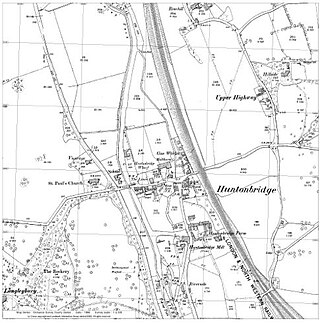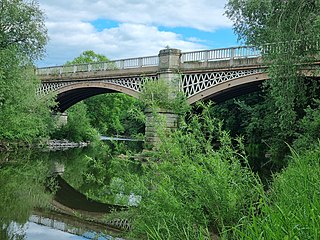
The Galton Bridge is a cast-iron bridge in Smethwick, near Birmingham, in the West Midlands of England. Opened in 1829 as a road bridge, the structure has been pedestrianised since the 1970s. It was built by Thomas Telford to carry a road across the new main line of the Birmingham Canal, which was built in a deep cutting. The bridge is 70 feet above the canal, making it reputedly the highest single-span arch bridge in the world when it was built, 26 feet wide, and 150 feet long. The iron components were fabricated at the nearby Horseley Ironworks and assembled atop the masonry abutments. The design includes decorative lamp-posts and X-shaped bracing in the spandrels.

The Store Street Aqueduct in central Manchester, England, was built in 1798 by Benjamin Outram on the Ashton Canal. A Grade II* listed building, it is built on a skew of 40° across Store Street, and is believed to be the first major aqueduct of its kind in Great Britain and the oldest still in use today.

Hunton Bridge is a small settlement near Abbots Langley, Hertfordshire, England, with a historic royal connection. Its population in the 1991 census was 327. It is in the Three Rivers population of Langleybury.

A skew arch is a method of construction that enables an arch bridge to span an obstacle at some angle other than a right angle. This results in the faces of the arch not being perpendicular to its abutments and its plan view being a parallelogram, rather than the rectangle that is the plan view of a regular, or "square" arch.

Southdown Road Skew Bridge is a ribbed skew arch railway bridge, which carries the Midland Main Line across Southdown Road in Harpenden, Hertfordshire. Built of brick by the Midland Railway and opening in 1868, it is notable for its extreme skew angle of approximately 65°.

Hereford Road Skew Bridge is a disused railway bridge in Ledbury, Herefordshire. Built in 1881 to carry the Ledbury and Gloucester Railway across the Hereford Road at an angle of approximately 45°, it was built as a ribbed skew arch with stone spandrels and wing walls, and ribs of blue brick. The railway line was closed in 1959 and the bridge is now used as part of the Ledbury Town Trail footpath.

Belvidere Bridge is a cast iron arch railway bridge in Shrewsbury, western England, built for the Shrewsbury and Birmingham Railway in 1849. It carries the modern Wolverhampton to Shrewsbury railway line over the River Severn and is a grade II* listed building.

The Wolverton Works canal bridge, or Bridge no. 171C, is a bridge over the Grand Union Canal in Wolverton, Milton Keynes in south-eastern England. It carries a spur from the West Coast Main Line into Wolverton Works. It was built in 1834–1835 for the London and Birmingham Railway under the supervision of Robert Stephenson and has been little modified since. It is a grade II* listed building.

The Gelt Bridge or Gelt Viaduct is a skew arch railway viaduct in the parish of Hayton, east of Carlisle in Cumbria, north west England. Built from 1832, it is one of the earliest and largest skew bridges in Britain. It is a Grade II* listed building.

Brandon Viaduct is a railway viaduct crossing the River Avon between the villages of Brandon and Wolston in Warwickshire. It carries the Birmingham Loop line and is roughly half way between Rugby and Coventry. The bridge was built in around 1835 for the London and Birmingham Railway and is now a grade II listed building.

The Sowe Viaduct is a railway bridge on the Birmingham Loop line crossing the River Sowe at the south-eastern edge of Coventry in central England. Built in 1838, it is a Grade II listed building.

The Sherbourne Viaduct is a railway bridge that carries the Birmingham Loop line across the River Sherbourne in Coventry, central England. Built in 1838, it is a grade II listed building.

Mile Lane Bridge is a road-over-rail bridge in Coventry, central England. It is possibly the first use of a flying arch over a railway cutting and is a Grade II listed building.

Wolverton Viaduct is a railway bridge carrying the West Coast Main Line over the River Great Ouse to the north of Wolverton, part of the City of Milton Keynes, in south-eastern England. Built in 1837 for the London and Birmingham Railway under the supervision of Robert Stephenson, it is one of the largest and most notable structures on the route and is a grade II listed building.

The Blisworth Arch is a railway bridge in Blisworth, Northamptonshire, in eastern England. It was designed by Robert Stephenson for the London and Birmingham Railway and completed in 1837. It is a grade II listed building and a significant local landmark.

Hampton in Arden packhorse bridge crosses the River Blythe near Hampton in Arden in the West Midlands of England, between Birmingham and Coventry. Dating from the 15th century, it is the only bridge of its kind in the area now covered by the West Midlands, and is a grade II* listed building and a scheduled monument.

The Brent Viaduct is a railway bridge carrying the West Coast Main Line over the valley of the River Brent just south of Stonebridge Park station in north-west London, England. Originally built in 1838 for the London and Birmingham Railway, it is now a Grade II listed building.

Bushey Arches Viaduct is a railway bridge on the West Coast Main Line immediately north of Bushey railway station, between Bushey and Watford, in Hertfordshire, Eastern England, just north-west of London.

The Colne Viaduct, also known as Five Arches Viaduct, carries the West Coast Main Line railway over the River Colne near Watford in Hertfordshire, Eastern England, just north-west of London. It was built in 1837 for the London and Birmingham Railway by Robert Stephenson.

Watford Tunnels are a pair of railway tunnels on the West Coast Main Line just north-west of Watford in Hertfordshire, Eastern England. The original was built in 1837 for the London and Birmingham Railway to the design of Robert Stephenson and is just over a mile long. When the line was widened in the 1870s, a second tunnel was built just to the east. Both tunnels had decorative portals and the south portal of the original tunnel is a Grade II listed building.





















